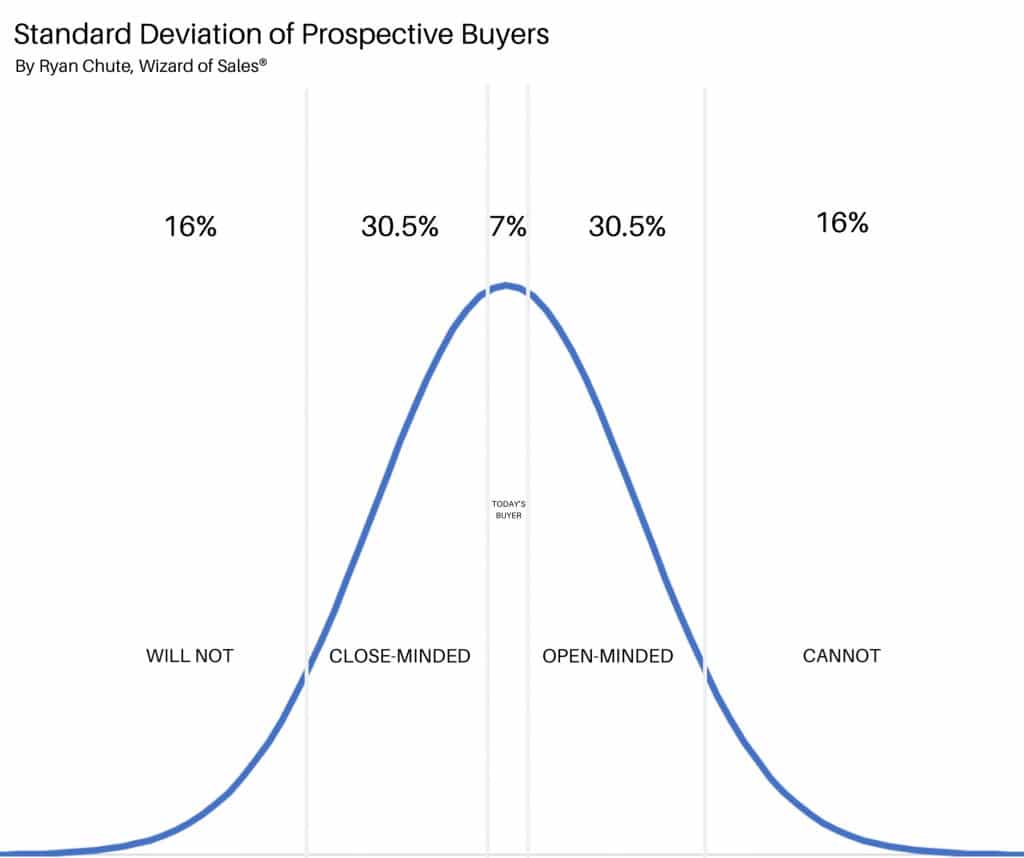
Having worked on 4 continents and 8 countries I’ve discovered one thing always stays the same – human psychology. While cultures and economics differ, people do not.
Psychology doesn’t change whether you live in Shanghai, China, or Corpus Christi, Texas. The good folks at the Center for Applications of Psychological Type have confirmed that certain personality preferences tend to skew in rural vs. urban areas, but on the whole, we can predict actions and behaviors with reasonable accuracy.
Decades of behavioral research has ascertained:
People will act within predictable standard deviations, based on normative needs. Any specific individual within the sample does not represent the whole.
Said differently:
Masses of People are predictable, though an individual person is not. The exception does not disprove the rule.
-Roy H. Williams

Therefore, behaviors can be charted out on a bell curve. Above, we can see the following standard deviations of prospective buyers in any reasonably-sized target market (yes, sample size matters):
- 16% will not buy
- 30.5% who may buy have some level of reluctance
- 7% of prospects are ready to buy today
- 30.5% who may buy are open to consideration
- 16% cannot buy
The 16% of people who will not buy include your competition, enemies, people named Todd, and a small subset of the population who are not willing to consider anything you have to say. You could offer these people a free truckload of gold and they would turn you down. Do not be put off by this group of people. They already lead a difficult life.
The next cross-section of 30.5% of the population could be swayed to considering options from your business, but your work is cut out for you. As the bell curves up to the apex, so too increases their propensity to buy. When you understand how to best approach each of the 6 objections in sales, you increase your likelihood of influencing these fine folks.
The middle 7% represent the proverbial needle in the haystack. These are the people that are ready and able to purchase your thing today. This minuscule subset is further carved up between two types of competition:
- The competition desperately standing-by to drop their drawers and bare all for a taste of some sweet sweet cash flow.
- The competition who has already won the heart of your mutual prospect, and therefore, have already won the game.
Moving to the next deviation, we see a second 30.5% of the population who are seen as willing participants in the sales arena. This group has the greatest potential to be swayed under two scenarios:
- They are presented with a compelling argument that this is an ideal opportunity to weigh their options.
- They are presented with an offer that is too-good-to-be-true on an infrequent basis.
The final 16% of people represent the most willing of participants, with no means or ability to buy. This included people without the money or good credit to purchase, those without jobs, or people outside a reasonable geography to receive your product. This group often includes the elderly, students, and the ill or infirm. This group includes the underprivileged or destitute, and you are best advised to never take advantage of a vulnerable person or situation.
Do you want to fight it out for 7% today, every day,
or do you want to easily sway 68% eventually?
Just know, it’s not just you; most of your competitors are fighting with you over the same group of people. Assuming all of your advertising is aimed at this 7% of prospects who are in the market today (discounts, loss leaders, sales events, etc.) then this means you are not connecting with people who might be in the market under the right terms and conditions with companies they love. This becomes your opportunity to dominate.
Since we won’t be able to sell the two outlier groups of 16% each, we are left with an additional 61% of potential buyers that could be swayed if they were presented with a non-salesy opportunity or they were presented with a too-good-to-be-true offer (or 871% more prospects). The more the prospects know, like, and trust you, the higher your likelihood of persuading them to consider one of your two approaches.
PRO TIP: do not overuse too-good-to-be-true offers as a tactic. Just like the boy who cried wolf, you will quickly appear untrustworthy.
The best way to drive exponential traffic to your front door is to stop targeting your advertising to the 7% of today’s buyers and start bonding with the 68% of all buyers who are open to being persuaded in an interesting and entertaining way. Because you’re advertising effectively in a noisy crowd, you capture the attention of the 7% you already want, but also the 61% you’re currently excluding.
FACT: This is precisely the reason your current lead generation efforts are producing low-quality, inconsistent results.
Repeat this success formula 7 days a week, 52 weeks of the year, and you will always win the game before the game has even begun.
Good selling.
Want to build an advertising strategy that is entertaining, endearing, and trustworthy? A smart prospecting system that compliments the perfect buying journey? A digital plan to match? Email me.
- Futuristic Game for the Ad Masters - July 11, 2024
- Classical Conditioning: Pavlov’s Dog in Advertising - June 20, 2024
- Hear, See, Speak No Advertising - June 9, 2024
